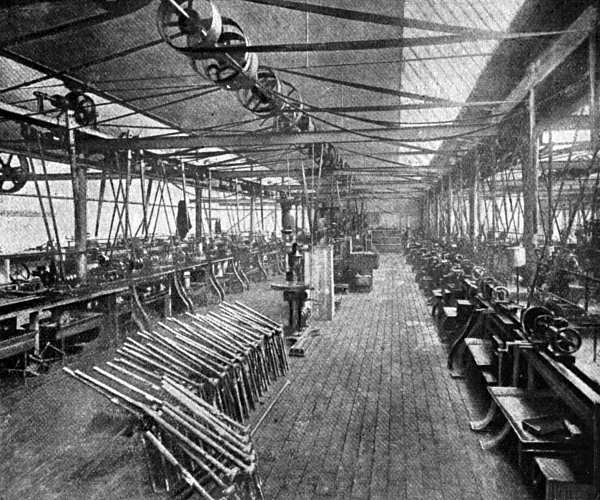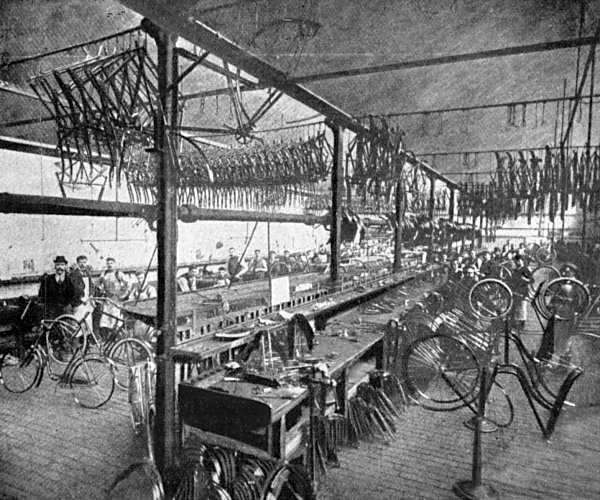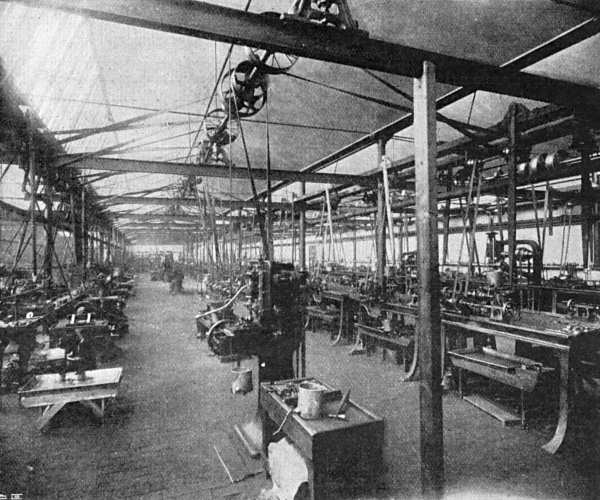|
Index...
|
 S an industry and as a popular sport, cycling cannot be accurately credited with an existence more prolonged than a couple of decades ; yet the historians aver that as far back as 1836 Mr. Kirkpatrick Macmillan invented the bicycle, while in the same year, one Gavin Dalzell, a Lesmahagow blacksmith, is reported to have applied cranks and pedals to a cycle of this description. Up to the period referred to the hobby-horse appears to have had all its own way ; and what that nondescript article was like we have all been able to see in the old print and bric-a-brac shops of Great Portland Street and other quarters of the Metropolis of late.
S an industry and as a popular sport, cycling cannot be accurately credited with an existence more prolonged than a couple of decades ; yet the historians aver that as far back as 1836 Mr. Kirkpatrick Macmillan invented the bicycle, while in the same year, one Gavin Dalzell, a Lesmahagow blacksmith, is reported to have applied cranks and pedals to a cycle of this description. Up to the period referred to the hobby-horse appears to have had all its own way ; and what that nondescript article was like we have all been able to see in the old print and bric-a-brac shops of Great Portland Street and other quarters of the Metropolis of late.
It was by the aid of cranks and levers from the rear wheel that the Macmillan "bike" was driven; but the machine was by no means kindly taken to, and for all practical purposes it must be regarded as still-born, giving place to the velocipede with four wheels constructed in 1837, 1838, and 1839 by Mr. Merryweather, Mr. Revis, and Mr. William Baddeley. In the very early days of the Crystal Palace these four-wheeled velocipedes were seen and ridden in the grounds of Paxton's Glass House at Sydenham; and in 1865 the original "bone-shaker" was shown at the Paris Exhibition by its inventor, M. Lalle-ment, who soon afterwards patented his production in the United States. I remember seeing one of these monsters in this country about the year 1868, and of essaying to mount it, with results the reverse to agreeable. Its proud owner was a youth who had just completed his education at a lycee in France ; and probably that fact in some measure accounted for its appearance in the Midland cathedral town in which I made its undesirable acquaintance. Lallement's original machine seems to date from 1860; and some eight years later Islington witnessed the opening of a school for the benefit of those sufficiently venturesome to risk life and limb on the well-named "bone-shaker." Cycling had a mild sort of vogue in Paris during the two or three years preceding the war with Germany ; and one of the first riders whom I recollect was the boy-Prince who subsequently became so great a favourite among us. More than this, the French favoured the water-cycle, which did not, however, find much patronage here.

It was from Paris, about 1869 or early in 1870, that Coventry received its first cycle, the son of one of the founders of what later became the Coventry Machinists' Company sending to his father one of the new machines, with an injunction to his parent to induce his firm to add cycle-making to the manufacture of sewing-machines. Then, about 1868, Mr. E. A. Cooper introduced a machine with hollow forks and a tubular backbone, following up this innovation by an attempt to reduce friction. Mr. Cooper, however, met with such scant encouragement that he abandoned the business, and left the task of further improvements to others. The present ball-bearings supplanted the roller-bearings invented by Mr. Cooper, whose ideas were largely utilised by the father of the cycle trade, Mr. James Starley, with whose monument all visitors to Coventry have become familiarised. Messrs. Haynes and Jefferies manufactured for James Starley his "Ariel" machine, which was awarded a prize medal at the International Exhibition held at South Kensington in 1873.
 hose who date the rage for cycling from the last three or four years will hear with surprise that nearly a quarter of a century has elapsed since the grand monde first took up the amusement, although, it is true, the votaries of the wheel were few and far between. Manchester was, perhaps, the first to inaugurate cycle races, and about the same time it is to be noted that clubs for cyclists began to spring up, among them being the Pickwick and the Middlesex Bicycling Club. The late Hon. Ion Keith - Falconer was one of the earliest devotees, and in the year 1874 attracted much admiring attention by riding 113 miles in rather more than nineteen hours, the course being from Bournemouth to Hitchin. Mr. Keith-Falconer was not only a crack rider in his day, but also a clever writer on the sport; the Field opened its columns to that gentleman, and may be cited as the first among influential journals to encourage the new pastime. There was an interesting and picturesque scene at Coventry in 1874, when their Royal Highnesses the Prince and Princess of Wales paid the old Warwickshire town a visit. An escort of crack wheelmen was a decided novelty in those remote days, and the rare spectacle drew tens of thousands of delighted sightseers.
hose who date the rage for cycling from the last three or four years will hear with surprise that nearly a quarter of a century has elapsed since the grand monde first took up the amusement, although, it is true, the votaries of the wheel were few and far between. Manchester was, perhaps, the first to inaugurate cycle races, and about the same time it is to be noted that clubs for cyclists began to spring up, among them being the Pickwick and the Middlesex Bicycling Club. The late Hon. Ion Keith - Falconer was one of the earliest devotees, and in the year 1874 attracted much admiring attention by riding 113 miles in rather more than nineteen hours, the course being from Bournemouth to Hitchin. Mr. Keith-Falconer was not only a crack rider in his day, but also a clever writer on the sport; the Field opened its columns to that gentleman, and may be cited as the first among influential journals to encourage the new pastime. There was an interesting and picturesque scene at Coventry in 1874, when their Royal Highnesses the Prince and Princess of Wales paid the old Warwickshire town a visit. An escort of crack wheelmen was a decided novelty in those remote days, and the rare spectacle drew tens of thousands of delighted sightseers.

At the period in question the cycle trade was in its infancy, but Coventry was even then distinguishing itself in the manufacture by turning out a few thousand machines annually. The Coventry Machinists' Company was one of the first of the now numerous organisations of which we have heard so much of late years ; and the firm which Mr. George Singer founded some twenty odd years ago was already being favourably heard of in the then comparatively limited cycle arena. As a matter of fact, the career of "Singers" extends over twenty-three years ; until now it enjoys the proud distinction of primus inter pares. During several visits which I have had the pleasure of paying to the Singer Cycle Company's leviathan works I have been struck by the absolute perfection of the various departments ; and, had space permitted, I should like to have said something anent the divisions of the world-famous manufactory which the artist has selected for pictorial treatment. No better idea of the extent to which cycling has taken hold of the upper stratum of society can be obtained than by ticking off the illustrious names which make of the Singer catalogue a species of "golden book." It is something to have catered, and to continue to cater, for the amusement of cycling Emperors, Kings, Queens, and reigning Princes, to say nothing of the gratin of English and foreign society ; and the evergreen George Singer may well feel proud that '97 is proving a record year for him and his associates. Some of the reflected glory of "Singers" falls upon the enterprising gentleman who reconstructed the undertaking (of which the founder happily remains the head) a brief year ago, and both the financial magician, Ernest Terah Hooley, and the cycle magnate, George Singer, may be congratulated upon the phenomenal development of the ever-extending business.
 ome twenty years have elapsed since the now universal tangent system of spokes was applied to the "Ariel" by Messrs. Haynes and Jefferies, whose Coventry tricycle, first introduced by them in 1876, was the forerunner of the "Coventry Rotary," the type of machine favoured by the Princess of Wales, for whom one of these beautiful "tris" was specially made early in 1896. It is not without interest to note that, soon after the appearance of the "ordinary," Dr. Cortis, on a machine of London build, known as the "Invincible," did twenty miles in less than an hour. As pace began to increase, and bicycles which could be easily mounted were loudly and widely demanded, makers turned their attention to the "safety." The invention of the rear-driver has been claimed by Mr. H. J. Lawson, who has recently identified himself with the motor-car industry, and has raised a mammoth factory at Coventry for the construction of those vehicles.
ome twenty years have elapsed since the now universal tangent system of spokes was applied to the "Ariel" by Messrs. Haynes and Jefferies, whose Coventry tricycle, first introduced by them in 1876, was the forerunner of the "Coventry Rotary," the type of machine favoured by the Princess of Wales, for whom one of these beautiful "tris" was specially made early in 1896. It is not without interest to note that, soon after the appearance of the "ordinary," Dr. Cortis, on a machine of London build, known as the "Invincible," did twenty miles in less than an hour. As pace began to increase, and bicycles which could be easily mounted were loudly and widely demanded, makers turned their attention to the "safety." The invention of the rear-driver has been claimed by Mr. H. J. Lawson, who has recently identified himself with the motor-car industry, and has raised a mammoth factory at Coventry for the construction of those vehicles.

About the same time (1879), or soon afterwards, Mr. Singer introduced a "safety" called the "'Xtraordinary," described by a cycling authority as "practically an ordinary bicycle, with the front fork raked more than usual, the cranks driven by oscillating levers, which brought the pedals under the rider." The lever-action was anything but an unqualified success, and twelve years ago Messrs. Starley and Sutton brought out the rear-driving safety, which, with certain modifications, is the "safety" as we know and ride it in this Jubilee year. Experts maintain that, but for the introduction of the rear-driving machine, cycling would not have attained a world-wide vogue: and they are doubtless right, for the old "ordinary" was the reverse of easy to mount. I venture, however, to assert that the present passion for cycling is very largely traceable to the invention by Mr. Dunlop of the pneumatic tyre, which is said to have made millionaires (or nearly so) of those who exploited it - namely, Mr. Harvey Du Cros and his sons. It was the Pneumatic Tyre Company and its plethoric assets and rights of all kinds which Mr. Hooley and Mr. Rucker purchased for three millions sterling, preparatory to offering it to the public for five millions. The complete story of this historic and sensational "deal" has yet to be told ; and the psychological moment for the telling of it is not yet.
Whether we regard cycling from the social, the sporting, or the financial point of view, its history is to the full as interesting as any prominent phase of our life during the last sixty years ; and as such it comes legitimately within the scope of literary treatment at a time when we are under the influence of "Diamond Jubilee" retrospect.
E. L.
Website by Rob Orland © 2002 to 2025